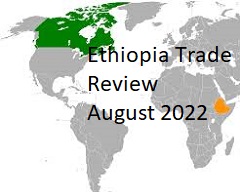Ethiopia’s Recent Trade Performance August 2022: A Data Pack and some observations
Export Outlook
The Government expects exports will reach $5.4bn this fiscal year, or growth of around 30 percent versus last year’s $4.1bn outturn. This growth could be justified by still-high global prices for coffee and gold (arabica coffee prices in July-August 2022 were already 25 percent higher than the 2021-22 average), by anticipated volume growth in the flowers and fruits/vegetables sectors (reflecting new investments and expansion in cultivated hectares), by on-going expansion of electricity exports to neighboring countries, and by the likely improvement of exports—such as meat—that are mainly geared towards the Middle Eastern market.
At the same time, the export growth prospects for what were previously large export categories—such as oilseeds, pulses, and chat—will likely remain somewhat restrained owing to unsettled conditions in parts of the relevant producing regions. Reflecting the latter factors, and an increasingly cloudy global economic environment, particularly in Europe, we think export growth of closer to 20 percent is more realistic and thus anticipate total exports reaching just under $5bn for this fiscal year.
Import outlook
The Government forecasts import growth will be 10 percent this fiscal year, per the recent 2022-23 Budget document. However, even with declines in commodity prices from their exceptional highs, this growth rate very likely understates the magnitude of the import increase for the year ahead.
An import growth rate in the mid- to high-teens seems more realistic, in our view, given still-high food import needs, large reconstruction requirements, and the limited volume adjustment being seen even in the face of elevated global prices (due to inelastic demand) for large-value imports such as fuel and fertilizers.
